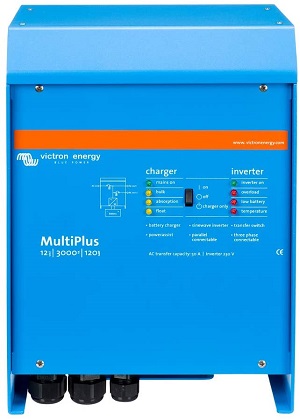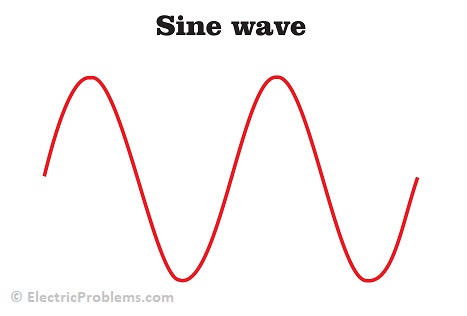![]()
Best RV Inverter Charger [Solar, 50-amp, 30-amp]
DISCLAIMER: AS AN AMAZON ASSOCIATE I EARN FROM QUALIFYING PURCHASES. THIS POST CONTAINS AFFILIATE LINKS THAT WILL REWARD ME MONETARILY OR OTHERWISE WHEN YOU USE THEM TO MAKE QUALIFYING PURCHASES. FOR MORE INFORMATION, PLEASE READ MY EARNINGS DISCLAIMER.
Are you looking for that freedom that the inverter-charger will give you by allowing you to live comfortably off the grid? With so many brands and inverter chargers out there, how would you pick the best one?
I did some research for you and this is what I found:
The best overall inverter charger for RV is Victron Energy MultiPlus. It’s a true sine wave inverter that has been tested by many RV owners (who are very happy with it). It can also be wired in parallel to give you more power, as a split-phase service (requires 2 of them) and a 3-phase power source.

It comes in 800VA, 1200VA, 1600VA, 2000VA, 3000VA, 5000VA (or watt) sizes, and is also reasonably priced. It’s a great all-in-one model for either solar, 50-amp (you will need one for each leg), or 30-amp service.
240VAC split phase capability is perfect for 50-amp RV setups (requires 2 units). Ratings and certifications are all in place along with an awesome 5-year warranty!
This is a very smart device that can do many things, including power (or load) assist, 4-stage charge control (which is even better than 3-stage charging for your batteries), and be your uninterruptible power backup in case the main power supply fails.
Why I picked it? First of all, there are quite a few reviews on it (which are positive) and second, it is known to be highly customizable. It is also a sine wave inverter:

“Modified sine wave” is NOT considered best by any means. Here is why. Even though it is really popular due to it being significantly cheaper, it is also known to produce a “rough” type of energy that will shorten the life of the equipment that uses motors and can completely damage sensitive electronics. Check out this video for more explanation:
Modified sine wave inverter chargers are known to produce a “humming sound” as they transform DC power into AC (Alternating Current). This is what a modified sine wave looks like:
![]()

A pure sine wave is the type of energy that you get from your utility company and a modified sine wave is a “some kind of” resemblance of it. These devices tend to overheat but are still acceptable in some cases.
The modified square wave is a lot better than a square wave though (which is NOT recommended at all due to safety and reliability issues):

Now, since I defined the “Best” as a “sine wave technology”, let’s get technical (at least, a little). People think that there are pros and cons to electronic or electrical devices, but this is simply not true!
There are just specs, nothing more! You either need certain options or you don’t.
This is what I mean. Let’s start with the electric setup that you have at this moment. Let’s say you have solar panels that supply you with energy and you want to use them to power your AC devices.
You can use different inverter chargers with solar panels, but some units are specifically made and tailored to your solar setup! It is also important to know what kind of setup you are planning to achieve.
It can be very simple (like plugging everything directly), all the way wiring different controllers in between for the most optimal (human-error-free) results. The rest comes down to the company (or brand) that you trust.
I picked several companies that are well known among the RV community (and not only) for being high quality with a good warranty and customer service. To make it on my list, their products need to be at least UL listed.
In this article, I will talk about the “best OFF grid solar inverter charger” and whatever works best for 50-amp and 30-amp services. Here are my top picks:
- Best for Solar: Renogy
- Best for 50-amp service: Go-Power!
- Best for 30-amp service: Xantrex Freedom
Here is why:
Best off-grid solar inverter charger
I picked this unit as the best choice because this company really knows about solar! It is a relatively inexpensive pure sine wave inverter charger with 4-stage (NOT 3-stage) battery charge control.
All the models I am comparing here are 3000 watts, but you can get the size that fits your needs better. The peak efficiency of this inverter charger is at 90% it has a low transfer time (which means for you that switching from solar to shore power will be almost seamless).
So, the winner in this section is:
Renogy 3000w 12v
This inverter charger is NOW compatible with lithium-ion batteries! Here is the sizing chart:
|
50 AH |
100 AH |
170 AH |
|
| 700 watts | 1 | 1 | 1 |
| 1000 watts |
2 | 1 | 1 |
| 2000 watts | 4 | 2 | 1 |
| 3000 watts |
6 | 3 | 2 |
Best inverter charger for 50-amp service
Now, about 50 amp services. Most inverter chargers allow you to connect a single unit to ONE power leg only, so in order to use this service to the maximum, you will need two of them.
The best inverter for 50-amp service (in my opinion) will allow you to use both legs with one unit only. It should also be compatible with the 30-amp service (in case that’s all you have available to get plugged into).
Unfortunately, I did NOT find too many inverter chargers that would do that. So, for 50-amp service, the winner is:
Go Power! GP-IC-3000-12
Why? It’s a solid product that will power both of your 120-volt (50 amp) lines. It includes 3-stage charge control and a battery temperature sensor.
But it does have certain limitations if you ever want to use it in “power assist mode”. The monitoring and power assisting is for ONE line only and here is a video on that:
![]()
This pure sine wave inverter charger will let you power your 50-amp service without using a second device. This company has a good reputation and its products are.
Best inverter charger for 30-amp service
For the 30 amp service, you don’t really need an inverter charger that is bigger than 3000 watts. Why? The reason is that this service can only handle 3,600 watts of power usage at the same time (30 amps x 120 volts).
Of course, if you want to go for maximum usage of your available (and very valuable) 3,600 watts, it is generally recommended to size your inverter about 20% more than the maximum power that you will use (which in our case is 3,600 watts). So, let’s calculate:
3,600 watts + 20% = 4,320 watts (or the 5,000w inverter charger)
Pure sine wave inverter chargers will be the best in this class as well. There are many good inverter-chargers out there that would be perfect for 30-amp service, so that was a tough call…
Since you don’t really need a split-phase capability for a 30-amp service, then there are many more choices than for a 50-amp service.
I did the research for the best “sine wave inverter charger for RV’s 30 amp service” and selected a winner:
Xantrex Freedom 815-3012
It comes with an automatic transfer switch that will seamlessly adjust between inverter and converter modes. Unfortunately, it is NOT a 240-volt split phase (which is essential for a 50-amp service), but overall, it is perfect for 30-amp service.
Xantrex Freedom inverter charger has a 3-stage charge control (which is perfect for batteries) along with temperature-compensated charging. Here a video with some happy Xantrex Freedom users and a complete installation procedure:
![]()
I will also include some installation guides from Xantrex to look through.

Click on the white button above to find your electrician!




Hi Konstantin,
Thanks for your thorough reviews and explanation of RV inverters. I have a new Tripp-Lite
RV30120EM inverter/charger installed on a houseboat in a marina. It has three indicator lights, red, yellow and green on the LINE side, and three for the BATTERY side. The LINE indicator is always yellow, indicating over or under voltage condition. The marina dock transformers are tapped at 129-130 volts to ensure adequate dock power for high-usage periods, i.e., summer holidays, when a lot of people are here, using air conditioners, etc. The Tripp-Lite will not operate above 126 volts.
Is it best to install a transformer in line to the inverter, or resisters to drop the voltage, or do you know of another brand that will operate at the higher voltage? Thank you.